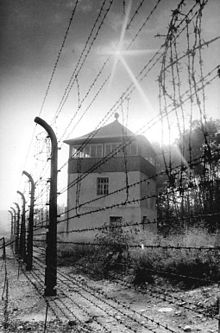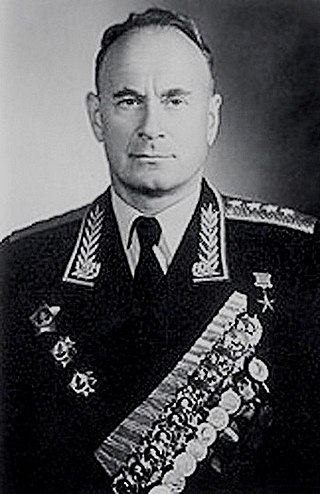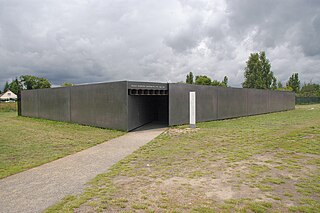
Mass surveillance in East Germany was a widespread practice throughout the country's history, involving Soviet, East German, and Western agencies.

Mass surveillance in East Germany was a widespread practice throughout the country's history, involving Soviet, East German, and Western agencies.

East Germany, known formally as the "German Democratic Republic" or the "Deutsche Demokratische Republik", was an Eastern Bloc state from 1949 to 1990. Its territory consisted of the region of Germany that had been controlled by Soviet forces at the end of World War II.
Penalties for unapproved political contacts were most severe. Though initially those sent to the NKVD camps were largely interned members of the Nazi Party or the juvenile Werwolf, sentenced inmates came to include many supporters of the Social Democratic Party of Germany (SPD), which became the focus of Soviet authorities in 1946. [1] When the Social Democratic Party was merged into the Communist Party of Germany (KPD), renamed Socialist Unity Party of Germany (SED), Social Democrats were interned to ensure Stalinist dominance in the party. [2] Also, people were interned as "spies" for suspected opposition to the authoritarian regime, e.g. for contacts to organizations based in the Western occupation zones, on the basis of Article 58 of the Soviet penal code dealing with "anti-Soviet activities". [2]
Of 123,000 Germans and 35,000 others held in the NKVD special camps, 43,000 died. [3] Of the 10,000 youths and children interned, half did not return. [4]
In 1947, the Soviet Military Administration in Germany (SMAD) issued Order No. 201, which established a fifth organization of Eastern German police, called Kommissariat 5 (K-5). The mission of K-5 was primarily to conduct surveillance of individuals in East Germany, especially those in East German governing bodies. [5] While nominally controlled by the young East German government, in practice, K-5 operated as a sub-unit of the Soviet KGB. [6] Most of K-5's cases came from the KGB, and KGB officers were present through the organization. KGB officers were involved in day-to-day K-5 operations like training and interrogations. [6]
On 8 February 1950, East Germany saw the establishment of the Ministry for State Security (Ministerium für Staatssicherheit), commonly known as the Stasi. [7] The Stasi sought to "know everything about everyone". [8] Its annual budget has been estimated at approximately $1 billion. [8] The Stasi kept files on about 5.6 million people. [9]
The Stasi had 90,000 full-time employees who were assisted by 170,000 full-time unofficial collaborators (Inoffizielle Mitarbeiter); together these made up 1 in 63 (nearly 2%) of the entire East German population. Together with these, a much larger number of occasional informers brought up the total to 1 per 6.5 persons. [10] [11] [12] [13] [14] [15]
People in East Germany were subjected to a variety of techniques, including audio and video surveillance of their homes, reading mail, extortion, and bribery. [16]

The West German intelligence agency Bundesnachrichtendienst (BND) employed approximately 10,000 East Germans as spies. [17]
The US National Security Agency (NSA) built one of its largest listening stations on top of Teufelsberg hill in the British sector of West Berlin, allegedly part of the global surveillance network ECHELON. "The Hill", as it was known colloquially, began operation in July 1961. [18] A large structure was built atop the hill, which would come to be run by the NSA (National Security Agency). Construction of a permanent facility was begun in October 1963. [18] The station continued to operate until the fall of East Germany and the Berlin Wall, after which the station was closed and its equipment removed. However, the huge buildings and massive radar domes still remain in place.

On 3 October 1990, the states of East Germany formally joined the Federal Republic of Germany to reunite East and West Germany.
As a result of the revolution, Stasi files fell into the hands of the reunited German government. The Federal Commissioner for the Stasi Records was formed to control those files.

The Ministry for State Security, commonly known as the Stasi ), an abbreviation of Staatssicherheit, was the state security-service of East Germany from 1950 to 1990.

Erich Fritz Emil Mielke was a German communist official who served as head of the East German Ministry for State Security, better known as the Stasi, from 1957 until shortly after the fall of the Berlin Wall in 1989.

Hans Modrow was a German politician best known as the last communist premier of East Germany.
Article 58 of the Russian SFSR Penal Code was put in force on 25 February 1927 to arrest those suspected of counter-revolutionary activities. It was revised several times. In particular, its Article 58-1 was updated by the listed sub-articles and put in force on 8 June 1934.

The Federal Intelligence Service is the foreign intelligence agency of Germany, directly subordinate to the Chancellor's Office. The BND headquarters is located in central Berlin. The BND has 300 locations in Germany and foreign countries. In 2016, it employed around 6,500 people; 10% of them are military personnel who are formally employed by the Office for Military Sciences. The BND is the largest agency of the German Intelligence Community.

Ivan Alexandrovich Serov was a Soviet intelligence officer who served as Chairman of the KGB from March 1954 to December 1958 and Director of the GRU from December 1958 to February 1963. Serov was NKVD Commissar of the Ukrainian SSR from 1939 to 1941 and Deputy Commissar of the NKVD under Lavrentiy Beria from 1941 to 1954.

The Lives of Others ) is a 2006 German drama film written and directed by Florian Henckel von Donnersmarck marking his feature film directorial debut. The plot is about the monitoring of East Berlin residents by agents of the Stasi, East Germany's secret police. It stars Ulrich Mühe as Stasi Captain Gerd Wiesler, Ulrich Tukur as his superior Anton Grubitz, Sebastian Koch as the playwright Georg Dreyman, and Martina Gedeck as Dreyman's lover, a prominent actress named Christa-Maria Sieland.
Jeffrey Martin Carney is a former United States Air Force intelligence specialist convicted of spying for East German Ministry for State Security. One of Stasi's most successful spies, code-named "Kid" or "Uwe", Carney became alienated and angry at the U.S. Air Force and U.S. policies under President Ronald Reagan. He began handing over U.S. military documents to the Stasi while working in West Berlin for the U.S. Air Force. After his transfer back to Goodfellow Air Force Base in 1984, Carney decided to once again request permanent asylum in East Germany. His whereabouts remained unknown until 1990 and he was carried on the rolls as a deserter.
James W. Hall III is a former United States Army warrant officer and signals intelligence analyst in Germany who sold eavesdropping and code secrets to East Germany and the Soviet Union from 1983 to 1988.
The Stasi Records Agency was the organisation that administered the archives of Ministry of State Security (Stasi) of the former German Democratic Republic. It was a government agency of the Federal Republic of Germany. It was established when the Stasi Records Act came into force on 29 December 1991. Formally it was called the Federal Commissioner for the Records of the State Security Service of the former German Democratic Republic ; the official German abbreviation was BStU. On June 17, 2021, the BStU was absorbed into the German Federal Archives (Bundesarchiv).

NKVD special camps were NKVD-run late and post-World War II internment camps in the Soviet-occupied parts of Germany from May 1945 to January 6, 1950. They were set up by the Soviet Military Administration in Germany (SMAD) and run by the Soviet Ministry of Internal Affairs MVD. On 8 August 1948, the camps were made subordinate to the Gulag. Because the camp inmates were permitted no contact with the outside world, the special camps were also known as silence camps.
NKVD special camp Nr. 2 was an NKVD special camp located at the site of the former Nazi Buchenwald concentration camp.

NKVD special camp Nr. 7 was a NKVD special camp that operated in Weesow until August 1945 and in Sachsenhausen from August 1945 until the spring of 1950. It was used by the Soviet occupying forces to detain those viewed as enemies of the people by the Soviet regime.
Hüseyin Yıldırım is a Turkish-American auto mechanic who was sentenced to life imprisonment in the United States for his courier role in the espionage activities of U.S. serviceman James Hall III during the Cold War era. Yıldırım was later pardoned and extradited to his homeland, where he was sentenced to 17 years in prison but served only one day.

Zersetzung was a psychological warfare technique used by the Ministry for State Security (Stasi) to repress political opponents in East Germany during the 1970s and 1980s. Zersetzung served to combat alleged and actual dissidents through covert means, using secret methods of abusive control and psychological manipulation to prevent anti-government activities. People were commonly targeted on a pre-emptive and preventative basis, to limit or stop politically incorrect activities that they may have gone on to perform, and not on the basis of crimes they had actually committed. Zersetzung methods were designed to break down, undermine, and paralyze people behind "a facade of social normality" in a form of "silent repression".

Helmut Müller-Enbergs is a German political scientist who has written extensively on the Stasi and related aspects of the German Democratic Republic's history.
An unofficial collaborator or IM ; both from German inoffizieller Mitarbeiter), or euphemistically informal collaborator, was an informant in the German Democratic Republic who delivered private information to the Ministry for State Security. At the end of the East German government, there was a network of around 189,000 informants, working at every level of society.
Rolf Henrich is a writer and lawyer. In September 1989 he became a co-founder and leading member of the New Forum movement.

The Memorial and Education Centre Andreasstraße, is a museum in Erfurt, Germany, which is housed in a former prison used by the East German Ministry for State Security (Stasi). It is informally known as the Stasi Museum.
Relations between East Germany and the United States formally began in 1974 until the former's collapse in 1990. The relationship between the two nations was among the most hostile during the Cold War as both sides were mutually suspicious of each other. Both sides conducted routine espionage against each other and conducted prisoner exchanges for their respective citizens which included spies for both the Americans and Soviets.
| Part of a series on |
| Mass surveillance |
|---|
| By location |